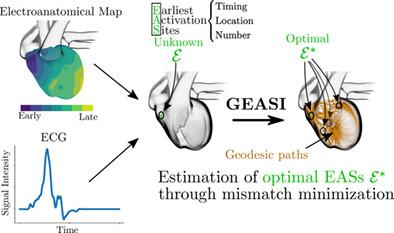当前位置:
X-MOL 学术
›
Int. J. Numer. Method. Biomed. Eng.
›
论文详情
Our official English website, www.x-mol.net, welcomes your
feedback! (Note: you will need to create a separate account there.)
GEASI: Geodesic-based earliest activation sites identification in cardiac models
International Journal for Numerical Methods in Biomedical Engineering ( IF 2.2 ) Pub Date : 2021-06-25 , DOI: 10.1002/cnm.3505 Thomas Grandits 1, 2 , Alexander Effland 1, 3, 4 , Thomas Pock 1, 2 , Rolf Krause 5 , Gernot Plank 2, 6 , Simone Pezzuto 5
International Journal for Numerical Methods in Biomedical Engineering ( IF 2.2 ) Pub Date : 2021-06-25 , DOI: 10.1002/cnm.3505 Thomas Grandits 1, 2 , Alexander Effland 1, 3, 4 , Thomas Pock 1, 2 , Rolf Krause 5 , Gernot Plank 2, 6 , Simone Pezzuto 5
Affiliation

|
The identification of the initial ventricular activation sequence is a critical step for the correct personalization of patient-specific cardiac models. In healthy conditions, the Purkinje network is the main source of the electrical activation, but under pathological conditions the so-called earliest activation sites (EASs) are possibly sparser and more localized. Yet, their number, location and timing may not be easily inferred from remote recordings, such as the epicardial activation or the 12-lead electrocardiogram (ECG), due to the underlying complexity of the model. In this work, we introduce GEASI (Geodesic-based Earliest Activation Sites Identification) as a novel approach to simultaneously identify all EASs. To this end, we start from the anisotropic eikonal equation modeling cardiac electrical activation and exploit its Hamilton–Jacobi formulation to minimize a given objective function, for example, the quadratic mismatch to given activation measurements. This versatile approach can be extended to estimate the number of activation sites by means of the topological gradient, or fitting a given ECG. We conducted various experiments in 2D and 3D for in-silico models and an in-vivo intracardiac recording collected from a patient undergoing cardiac resynchronization therapy. The results demonstrate the clinical applicability of GEASI for potential future personalized models and clinical intervention.
中文翻译:

GEASI:心脏模型中基于测地线的最早激活位点识别
初始心室激动序列的识别是正确个性化患者特定心脏模型的关键步骤。在健康条件下,浦肯野网络是电激活的主要来源,但在病理条件下,所谓的最早激活位点(EAS)可能更稀疏且更局部化。然而,由于模型的潜在复杂性,它们的数量、位置和时间可能不容易从远程记录中推断出来,例如心外膜激活或 12 导联心电图 (ECG)。在这项工作中,我们引入了 GEASI(基于测地线的最早激活位点识别)作为一种同时识别所有 EAS 的新方法。为此,我们从模拟心脏电激活的各向异性程方程开始,并利用其汉密尔顿-雅可比公式来最小化给定的目标函数,例如,与给定激活测量的二次失配。这种多功能方法可以扩展到通过拓扑梯度或拟合给定心电图来估计激活位点的数量。我们对计算机模型进行了各种 2D 和 3D 实验,并从接受心脏再同步治疗的患者身上收集了体内心内记录。结果证明了 GEASI 对于未来潜在的个性化模型和临床干预的临床适用性。
更新日期:2021-08-10
中文翻译:

GEASI:心脏模型中基于测地线的最早激活位点识别
初始心室激动序列的识别是正确个性化患者特定心脏模型的关键步骤。在健康条件下,浦肯野网络是电激活的主要来源,但在病理条件下,所谓的最早激活位点(EAS)可能更稀疏且更局部化。然而,由于模型的潜在复杂性,它们的数量、位置和时间可能不容易从远程记录中推断出来,例如心外膜激活或 12 导联心电图 (ECG)。在这项工作中,我们引入了 GEASI(基于测地线的最早激活位点识别)作为一种同时识别所有 EAS 的新方法。为此,我们从模拟心脏电激活的各向异性程方程开始,并利用其汉密尔顿-雅可比公式来最小化给定的目标函数,例如,与给定激活测量的二次失配。这种多功能方法可以扩展到通过拓扑梯度或拟合给定心电图来估计激活位点的数量。我们对计算机模型进行了各种 2D 和 3D 实验,并从接受心脏再同步治疗的患者身上收集了体内心内记录。结果证明了 GEASI 对于未来潜在的个性化模型和临床干预的临床适用性。











































 京公网安备 11010802027423号
京公网安备 11010802027423号